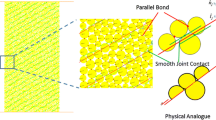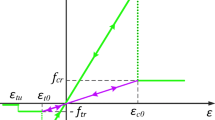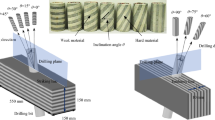Abstract
Anisotropic rock masses, the behavior of which is dominated by closely spaced planes of weakness, present particular difficulties in rock engineering analyses. The orientation of discontinuities relative to an excavation face has a significant influence on the behavioral response. At the present time, discontinuum modeling techniques provide the most rigorous analyses of the deformation and failure processes of anisotropic rock masses. However, due to their computational efficiency continuum analyses are routinely used to represent laminated materials through the implementation of a Ubiquitous-Joint model. The problem with Ubiquitous-Joint models is that they do not consider the effects of joint spacing, length and stiffness. As such, without an understanding of the limitations of the modeling approach and detailed calibration of the material response, simulation results can be misleading. This paper provides a framework to select and validate ubiquitous-joint constitutive properties.



























Similar content being viewed by others
References
Adhikary DP (2010) Shortcomings in the standard continuum based implicit joint model of layered rocks. J Geol Min Res 2(2):23–28
Al-Harthi AA (1998) Effect of planar structures on the anisotropy of Ranyah sandstone, Saudi Arabia. Eng Geol 50:49–57
Board M, Chacon E, Varona P, Lorig L (1996) comparative analysis of toppling behaviour at chuquicamata open—pit mine, Chile. Trans Inst Min Metall A 105:A11–A21
Brady BHG, Brown ET (2004) Rock mechanics for underground mining, 3rd edn. Springer, New York
Brown ET, Richards LR, Barr MV (1977) Shear strength characteristics of delabole slates. In: Proceedings of conference rock engineering, Univ Newcastle upon Tyne
Cai M, Kaiser PK, Tasaka Y, Minami M (2007) Determination of residual strength parameters of jointed rock masses using the GSI system. Int J Rock Mech Min Sci 44:247–265
Clark I (2006) Simulation of rock mass strength using ubiquitous-joints. In: Hart R, Varona P (eds) Proceedings of 4th international FLAC symposium on numerical modeling in geomechanics—2006, Madrid, Spain. Paper no. 08–07, Minneapolis, Itasca
Cundall PA, Fairhurst C (1986) Correlation of discontinuum models with physical observations—an approach to the estimation of rock mass behavior. Felsbau 4:4
Damjanac B, Board M, Lin M, Kicker D, Leem J (2007) Mechanical degradation of emplacement drifts at Yucca Mountain—a modeling case study part II: lithophysal rock. Int J Rock Mech Min Sci 44:368–399
Dawson EM, Cundall PA (1992) Cosserat plasticity for modeling lay red rock. In: Proceedings, ISRM regional conference on fractured and jointed rock masses (Lake Tahoe, June 1992), vol 2. Lawrence Berkeley Laboratory, Berkeley, pp 269–276
Dawson EM, Cundall PA (1996) Slope stability using micropolar plasticity. In: Aubertin M et al (eds) Rock mechanics tools and techniques (2nd North American Rock mechanics symposium, Montréal, June 1996), vol 1. Balkema, Rotterdam, pp 551–558
Donath FA (1972) Effects of cohesion and granularity on deformational behavior of anisotropic rock. Studies in mineralogy and precambrian geology. Geol. Soc. Am Memoir 135:95–128
Fairhurst C, Damjanac B, Brandshaug T (2006) Rock mass strength and numerical experiments. In: Publications of the geotechnical institute no. 2006-5 (Proceedings, 35 Geomechanics Colloquium, November 2006). Technical University Mining Academy Freiberg, Freiberg, pp 1–20
Gao FQ, Stead D (2014) The application of a modified Voronoi logic to brittle fracture modelling at the laboratory and field scale. Int J Rock Mech Min Sci 68:1–14
Hoek E, Brown ET (1980) Underground excavations in rock. Institution of Mining and Metallurgy, London
Hoek E, Kaiser PK, Bawden WF (1995) Support of underground excavations in hard rock. Balkema, Rotterdam, p 215
Itasca Consulting Group, Inc. (2007) 3DEC—3-dimensional distinct element code, version 4.1. Itasca, Minneapolis
Itasca Consulting Group, Inc. (2011) UDEC—universal distinct element code, version 5.0. Itasca, Minneapolis
Itasca Consulting Group, Inc. (2012) FLAC3D—fast lagrangian analysis of continua in three-dimensions, version 5.0. Itasca, Minneapolis
Jaeger JC (1960) Shear failure of anisotropic rocks. Geol Mag 97:65–72
Jaeger JC, Cook NGW (1976) Fundamentals of rock mechanics, 3rd edn. Chapman and Hall, New York
Kale SM, Trudinger JP (1975) Slope stability investigations at the Mt. Whaleback iron ore mine, Western Australia. In: Papers presented at the SA conference 1975. Part B: Whyalla, Leigh Creek, and Adelaide. AusIMM, B, pp 571–583
Karampinos E, Hadjigeorgiou J, Hazzard J, Turcotte P (2015) Discrete element modelling of the buckling phenomenon in deep hard rock mines. Int J Rock Mech Min Sci 80:346–356
Leitner R, Potsch M, Schubert W (2006) Aspects on the numerical modeling of rock mass anisotropy in tunneling. Felsbau 24:2
McLamore R, Gray KE (1967) The mechanical behavior of anisotropic sedimentary rocks. J Energy Ind Trans Am Soc Mech Eng Ser B 89:62–73
Mühlhaus HB (1993) Continuum models for layered and blocky materials. In: Comprehensive rock mechanics, Pergamon Press, pp 209–230
Perman F, Sjoberg J, Dahner C (2011) Detailed three-dimensional stress analysis of complex orebody geometry—model setup and results for the Malmberget Mine. In: Sainsbury, Hart, Detournay, Nelson (eds) Continuum and distinct element numerical modeling in geomechanics—2011. Paper: 02-04, Itasca International Inc., Minneapolis. ISBN: 978-0-9767577-2-6
Riahi A, Curran JH (2008) Application of Cosserat continuum approach in the finite element shear strength reduction analysis of jointed rock slopes. In: Geomechanics in the emerging social & technological age (CD proceedings, 12th IACMAG conference, Goa, India, October 2008), paper no. A15. X-CD Technologies Inc, Toronto
Riahi A, Curran JH (2009) Full 3D finite element Cosserat formulation with application in layered structures. Appl Math Model 33(8):3450–3454
Sainsbury B (2012) A model for cave propagation and subsidence assessment in jointed rock masses. A Thesis submitted to The University of New South Wales in fulfilment of the requirements for the degree Doctor of Philosophy, August 2012
Sainsbury D, Sainsbury B (2013) Three-dimensional analysis of pit slope stability in anisotropic rock masses. In: Proceedings of slope stability 2013, Brisbane, Australia
Sainsbury B, Pierce M, Mas Ivars D (2008) Analysis of caving behavior using a synthetic rock mass (SRM)—ubiquitous-joint rock mass (UJRM) modeling technique. In: Proceedings of the 1st southern hemisphere international rock mechanics symposium (SHIRMS), September, 2008
Sainsbury D, Sainsbury B, Sweeney E (2016a) Three-dimensional analysis of complex anisotropic slope instability at MMG’s century mine. Min Technol. doi:10.1080/14749009.2016.1163918
Sainsbury D, Sainsbury B, Paetzold H-D, Lourens P, Vakili A (2016b) Cave propagation and subsidence behaviour of lift 1 at the Palabora block cave mine. In: Seventh international conference & exhibition on mass mining—MassMin Sydney 2016
Salcedo DA (1983) Macizos Rocosos: Caracterización, Resistencia al Corte y Mecanismos de Rotura. In: Proceedings of 25 Aniversario Conferencia Soc. Venezolana de Mecánica del Suelo e Ingeniería de Fundaciones, Caracas, pp 143–172
Singh J, Ramamurth T, Venkatappa RG (1989) Strength anisotropies in rocks. Indian Geotech J 19(2):147–166
Tien YM, Kuo MC, Juang CH (2006) An experimental investigation of the failure mechanism of simulated transversely isotropic rocks. Int J Rock Mech Min Sci 43:1163–1181
Yoshinaka R, Osada M, Park H, Sasaki T, Sasaki K (2008) Practical determination of mechanical design parameters of intact rock considering scale effect. Eng Geol 96:173–186
Acknowledgements
The authors would like to thank the management team at Castlemaine Goldfields Limited for their permission to publish this work. We would also like to acknowledge the assistance of Christine Detournay (Itasca Consulting Group) for her constructive review of the paper.
Author information
Authors and Affiliations
Corresponding author
Rights and permissions
About this article
Cite this article
Sainsbury, B.L., Sainsbury, D.P. Practical Use of the Ubiquitous-Joint Constitutive Model for the Simulation of Anisotropic Rock Masses. Rock Mech Rock Eng 50, 1507–1528 (2017). https://doi.org/10.1007/s00603-017-1177-3
Received:
Accepted:
Published:
Issue Date:
DOI: https://doi.org/10.1007/s00603-017-1177-3




